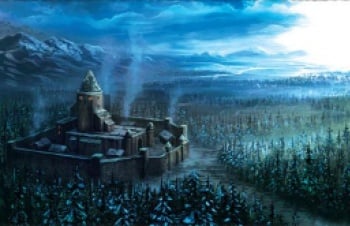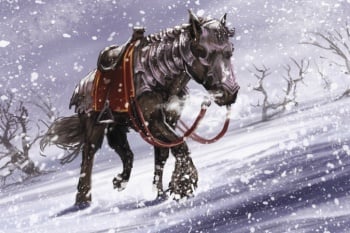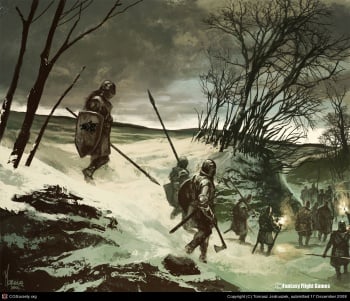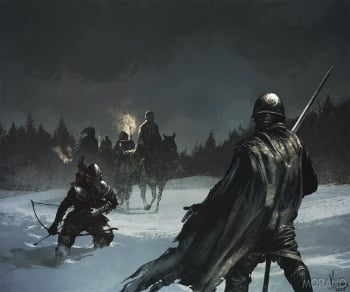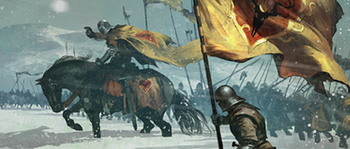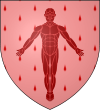North
The north[1][2][3], or the North[4], or the winterlands[5] is one of the constituent regions of Westeros and was a sovereign nation ruled by Kings in the North before Aegon's Conquest. The largest region of the Seven Kingdoms,[6] the dominion of House Stark extends from the border of the New Gift, which is controlled by the Night's Watch, to the southern edge of the Neck far to the south.[4]
The north has been ruled by the Starks for thousands of years from the castle known as Winterfell. The only city in the region is White Harbor, while the most prominent northern towns are the winter town and Barrowton.[4] Notable bannermen of the region include Bolton, Cerwyn, Dustin, Flint, Glover, Hornwood, Karstark, Manderly, Mormont, Reed, Ryswell, Tallhart, and Umber.[7][8] Bastards of noble origin raised in the north are given the surname Snow.[9]
Contents
Geography
George R. R. Martin has indicated that Scotland is an inspiration for the north.[10] While some say the vast north is nearly as large as the rest of the Seven Kingdoms combined,[6] in actuality it is roughly a third of the landmass controlled by the Iron Throne.[4] The region is sparsely populated, with vast wilderness, rising moorlands, high plains, forests, pine-covered hills and snow-capped mountains, speckled with tiny villages and holdfasts. The cold north is much less fertile than provinces in southern Westeros. Its harsh climate is deadly in winter and occasionally it will snow even in summer.[4] The north has two major land barriers, the Wall to the north and the Neck to the south. The north is bound on each side by major seas, the Shivering Sea to the east and the Sunset Sea to the west.[11]
Winterfell, the ancestral seat of House Stark, is a large castle at the center of the north. Nearby is the winter town. The vast wolfswood, the largest forest of the Seven Kingdoms, extends northwest to the Bay of Ice and Sea Dragon Point. Deepwood Motte, the seat of House Glover, lies in the western wolfswood. House Mormont rules Bear Island in the Bay of Ice. The northern mountains extend from the wolfswood to the Wall and are inhabited by northern mountain clans.[11]
South of the wolfswood is hilly terrain with several large lakes. Torrhen's Square, seat of House Tallhart, is by the largest of these lakes. Farther west along the Sunset Sea is the Stony Shore, which contains fishing villages. Southeast of the Stony Shore and north of Blazewater Bay is the Rills, plains which are ruled by House Ryswell. East of the Rills and south of Winterfell are the barrowlands, hilly plains dotted with the barrows of the First Men. House Dustin rules the large town of Barrowton. There are unnamed rivers which flow south from Barrowton and near Torrhen's Square into the Saltspear, while another unnamed river divides the Stony Shore from the Rills.[11]
South of the barrowlands is the Neck, an isthmus forming the border with the riverlands to the south. A vast swamp and the source of the Green Fork, the Neck is home to the crannogmen; House Reed rules from the moving castle Greywater Watch.[12] The ruined castle of Moat Cailin, on the causeway near the Fever River, controls access to the north from the Neck. Here the Kings in the North held off southron invasions.[13]
A large peninsula is west of the Neck and south of the Saltspear and Blazewater Bay. Flint's Finger, home of House Flint of Flint's Finger, is on its north shore, and Cape Kraken and the Flint Cliffs are along its western and southern shores. South of the peninsula are Ironman's Bay and the Iron Islands.[14]
East of the barrowlands is the White Knife, a major river of the north which has its source at Long Lake northeast of Winterfell. Castle Cerwyn, the seat of House Cerwyn, is near a tributary south of Winterfell. The White Knife runs south to White Harbor, one of the major cities of the Seven Kingdoms and the main port of the north. Southeast of White Harbor is Oldcastle, the seat of House Locke, while farther east are Ramsgate and the Broken Branch, which has its source in the Sheepshead Hills northeast of White Harbor. Widow's Watch, the castle of House Flint of Widow's Watch, is built on an isolated peninsula east of Ramsgate in the Shivering Sea.[11] The Bite separates the southeastern North, much of which is influenced by House Manderly of White Harbor,[15] from the Vale of Arryn.
Hornwood, the seat of House Hornwood, is in the Hornwood forest north of White Harbor and south of the Dreadfort, the seat of House Bolton. The Dreadfort lies near the Weeping Water, which flows east to the Shivering Sea. Northeast of the Dreadfort are the forested lands of House Karstark. East of their castle, Karhold, are the Grey Cliffs.[11] In the Bay of Seals are several islands, including Skagos and uninhabited Skane. The largest, Skagos, is said to be inhabited by cannibals and unicorns and is only nominally controlled by the Starks of Winterfell.[16]
North of Winterfell and the Dreadfort and northwest of Karhold are the lands of House Umber, whose castle of Last Hearth is in a forest. The Umbers control the Lonely Hills[17] and land along the Bay of Seals.[9] Beginning near Last Hearth, the Last River flows southeast between Karhold and the Dreadfort.[11]
The Wall is a colossal fortification that protects the north from threats beyond the Wall, such as wildlings. It is separated from the northern lands owing allegiance to Winterfell by the Gift, which are lands of the Night's Watch north of the Umbers' lands.[18]
Winterfell and Moat Cailin are along the kingsroad, which connects Castle Black at the Wall with the riverlands to the south. There are farms, holdfasts, inns, and villages along the road.[19][20]
The land of the north is not seen as valuable by many south of the Neck.[21][22]
Seasons
The north is strongly affected during the long winters, with thousands of people killed and famine a common occurrence due to poor harvests before winter or the inability to raise crops during the longer winters that last for years on end. Some greater lords maintain greenhouses at their castles, such as the glass gardens of Winterfell.[23]
Once autumn is declared by the Citadel, the lords of the north store away a part of the grain they have harvested. How much is a matter of choice; between one fifth and one fourth seems prudent, however.[9] Additionally food is smoked, salted, and otherwise preserved ahead of winter. Coastal communities depend on fish and inland ice fishing is common on the rivers and Long Lake. Poor harvests before winter will mean famine, however.[23]
In winter, snows can fall forty feet deep.[24] Rain falls cold and hard, and sometimes turns into ice that can send men running for cover and ruin crops.[25] Even during summer, snowfalls are not unusual but tend to be brief and not particularly damaging to agriculture.[6]
People
Most northmen are descended from the First Men, although there have been centuries of intermarriage with the Andals who conquered south of the Neck.[26] The Old Tongue spoken by the First Men of antiquity has been replaced in the north by the Common Tongue, with the earlier language now only spoken beyond the Wall.[4] Northern accents can be considered "frosted".[27]
Many northmen, including Karstarks and Umbers, are large in stature and have thick beards, long hair, and heavy cloaks of wool or fur.[28][29] During the Dance of the Dragons, for instance, Mushroom compared the host of Lord Cregan Stark to armored bears.[29] Northern warriors can ride shaggy horses.[30]
The constant cold and the iron grip of winter set apart the northerners from the people of the kingdoms south of the Neck. The north's terrain and climate do not easily yield the necessities of daily life. Northmen place less of an emphasis on courtly ritual and culture, and instead prefer hunting and brawling. Many northmen disapprove of tourneys and gambling.[25] Northern competitions rarely feature jousting, preferring instead dangerous melees,[4] and northmen also make up their own rules for tourneys.[31]
Guest right is treasured in the north.[4] Northmen have long memories, and a lord who does not seek his rightful vengeance threatens to have his own men turn on him.[28] A northern custom is that when someone is condemned to death, he who passes that sentence should swing the sword.[29][1]
Some northmen live in remote, distant areas where they act as little more than clans and tribes. These remote folk, such as the crannogmen, the northern mountain clans, and the Skagosi, are still vassals of the Starks, however, and are allowed to maintain their own ways and traditions as long as they remain loyal to Winterfell. Some maesters believe the blood of Cape Kraken's people is closer to that of ironborn than northmen.[32]
Most of the north's people still follow the old gods and their heart trees, and have little inclination for newer religions. There are only a few houses who follow the Faith of the Seven,[33] with House Manderly the most prominent.[34] Due to its religious aspect, most northmen refuse to take holy orders and thus cannot become knights, although some northern cavalry are knights who still follow the old gods instead of the Seven.[15] Most knights of the north live in the region's southern lands, such as White Harbor[35] and the barrowlands.[36] Heraldry in the north is simpler than that in southern Westeros, showing the lesser influence that chivalry has had there.[37]
Northmen hold the Night's Watch in high regard,[29] and many lords send annual gifts to support the black brothers.[38]
The first night was allowed in the north until Queen Alysanne Targaryen convinced King Jaehaerys I Targaryen to abolish it.[34] Some northern lords still discretely practice it, however.[39]
During harsh winters, many farmers and younger northmen seek refuge in the winter town or at the castles of lords.[40][41] To preserve resources for the younger generations, many older northmen leave their home to hunt during winter, with most not surviving until spring.[41] Men who are old, childless, homeless, or younger sons also traditionally joined winter armies which marched for adventure and plunder with no expectation of survival.[29]
Northmen are often considered savage, wild, and fierce by southrons.[42][29][43][44][45][46] Northmen are sometimes referred to as "wolves" by ironborn[47] and southerners.[48] Since most northmen pray before heart trees instead of following the Seven in septs, some southrons consider them to be godless[29] or tree worshipers.[17]
Economy
As the north is largely uncultivated, there are few roads of import there. Most of the inland trade passes by either the kingsroad or the rivers. Trade items from the north include wool,[49][33] hides,[33] and timber.[33] White Harbor, the main port town of the north,[50] contains silversmiths[51] and the Old Mint.[33] Food can be shipped from the south through the narrow sea to the northern city.[50]
Military strength
The north's exact military strength has not yet been revealed. According to a semi-canon source from 2005, the north can perhaps raise forty-five thousand soldiers,[52] although it takes a long time for armies to be gathered from such a large region.[42][53] According to George R.R. Martin, the north's military strength is about equal to that of the Vale of Arryn, and Dorne.[53] During Aegon's Conquest, King Torrhen Stark raised an army of thirty thousand men.[54] Nearly twenty thousand can be raised on short notice[13] near the start of autumn,[55] while thousands more might be raised from more distant houses, such as the mountain clans, if more time is allowed.[17]
A semi-canon source from 2005 places the infantry-to-cavalry ratio at four to one.[52] House Manderly, of southron origins, is known to command the most heavy horse north of the Neck.[15] Mail is the most common armor found in the north.[56] As knighthood is associated with the Faith of the Seven, and the majority of the northmen holds to the old gods, knighthood is rare in the north.[36]
The north has had no strength at sea since Brandon the Burner set fire to the remaining fleet of his father, Brandon the Shipwright.[9]
History
Dawn Age
During the Dawn Age, Westeros was inhabited by children of the forest and by giants.[57] Maester Kennet has found evidence that giants who lived in what is now the north buried their dead.[57]
The human peoples of the north are nearly all descended from the First Men, who settled the land between eight thousand and twelve thousand years ago.[58] Little is known of that time, but cryptic runes carved in old stones and the barrows of the First Men can still be found in the barrowlands. Ancient forts of the First Men are scattered throughout the north, including a ringfort atop Seal Rock near White Harbor[33] and ruins in Sea Dragon Point.[3] The children of the forest also made weirwood circles.[3]
Kings of Winter
About eight thousand years ago, the legendary Long Night occurred when the Others invaded from the Lands of Always Winter. The event defined and shaped the north, leading to the founding of the Wall, the order of the Night's Watch, the castle of Winterfell, and the first Kings of Winter from House Stark. Brandon the Breaker is said to have allied with Joramun, a King-Beyond-the-Wall, to bring down the Night's King.[38]
The Starks gradually defeated rival kings, such as the Barrow Kings to their south and the Red Kings to their east.[8] During the coming of the Andals, the Kings of Winter stopped Andals at Moat Cailin and the eastern shores, the only kingdom in Westeros to do so.[59][8]
King Jon Stark founded the Wolf's Den at the mouth of the White Knife after driving out sea raiders.[15] His son, Rickard Stark, conquered the Neck from the Marsh King and married his daughter.[59] King Rodrik Stark is said to have won Bear Island from the ironborn in a wrestling match.[59] Two thousand years ago the north warred with the Vale of Arryn after the Rape of the Three Sisters, with the Arryns eventually gaining control of the islands in this War Across the Water.[60][61]
Thousands of years before Aegon's Conquest,[34] King Brandon the Shipwright attempted to sail across the Sunset Sea, but never returned back home. His son, also named Brandon, burned the northern shipyards in his grief.[59] The north has since lacked strength at sea.[9]
For many centuries the Boltons were bitter rivals of the Starks of Winterfell. The practice of flaying their enemies gave the Boltons a sinister reputation. It is said that a thousand years ago, the Boltons finally swore fealty to the Kings in the North and agreed to abandon their practice of flaying their enemies.[62]
Around a thousand years ago, the Manderlys were driven from the river Mander by Perceon III Gardener,[8] King of the Reach, and fled to the north, where they were welcomed by the Starks of Winterfell as their own bannermen.[63] The Manderlys received the Wolf's Den and developed White Harbor, one of the five cities of Westeros and the main northern port for commerce and naval transport. The Manderlys are the most prominent of the few northern noble houses to follow the Faith of the Seven instead of the old gods.[34]
Targaryen Era
The Starks led the north to war during Aegon's Conquest. After the Field of Fire, however, King Torrhen Stark knelt to Aegon the Conqueror rather than face his dragons. The north was included in the Seven Kingdoms and owed allegiance to the Iron Throne of House Targaryen. The Stark Kings in the North became the Lords of Winterfell and Wardens of the North. Some northmen who refused to bend the knee fled into exile in Essos and formed the Company of the Rose.[64]
Queen Alysanne Targaryen convinced her husband, King Jaehaerys I Targaryen, to grant the New Gift to the Night's Watch[65] despite the objections of Lord Ellard Stark.[66]
During the Dance of the Dragons, the Starks supported the blacks against the greens. Lord Roderick Dustin led two thousand northern soldiers, known as the Winter Wolves, during the war, while the Manderlys had knights from White Harbor also support the claim of Rhaenyra Targaryen.[67] Lord Cregan Stark led a great host of northmen to King's Landing, where he briefly ruled as Hand of the King for Aegon III Targaryen during the Hour of the Wolf.[43]
Lord Dagon Greyjoy led the ironborn in raiding the north during the reign of King Aerys I Targaryen; Lord Beron Stark gathered swords to repel them.[44]
The people of the north must be vigilant against wildlings who manage to bypass the Wall. One King-beyond-the-Wall, Raymun Redbeard, was defeated by the Starks and Umbers at Long Lake.[68]
A century ago the Skagosi unsuccessfully rebelled against the Starks, costing the lives of Lord Barthogan Stark and hundreds of his supporters.[16]
Robert's Rebellion
The northmen composed much of the rebel forces during Robert's Rebellion, also known as the War of the Usurper. After King Aerys II Targaryen caused the deaths of Lord Rickard Stark and his heir, Brandon Stark, their successor, Lord Eddard Stark, led armies alongside Lord Robert Baratheon, who was crowned King Robert I at war's end.[69]
Recent Events
A Game of Thrones
King Robert I Baratheon travels from King's Landing to Winterfell to offer the position of Hand of the King to his old friend, Lord Eddard Stark, which the Warden of the North reluctantly accepts.[70][71]
When Eddard is later imprisoned in the Red Keep after the death of Robert, his heir, Robb Stark, calls the northern banners to Winterfell and marches south to rescue Eddard[36] with a strength of nearly twenty thousand[13][2] close to the start of autumn.[55] House Karstark contributes at least two thousand three hundred men, mostly infantry.[36] House Manderly provides at least fifteen hundred,[13] but it is not their full strength.[15] House Dustin sends a minimal amount.[72] Of the four thousand armored lances who come to Winterfell, only three or four hundred are knights.[36]
Robb is victorious over House Lannister forces in the Whispering Wood and the Battle of the Camps, but Lord Roose Bolton is defeated by Lord Tywin Lannister on the Green Fork. After hearing that King Joffrey I Baratheon ordered the execution of Eddard, the assembled northern and river lords in Riverrun reject the sovereignty of the Iron Throne and proclaim Robb to be King in the North.[73]
A Clash of Kings

With Robb campaigning south of the Neck, his younger brother Bran remains as the Stark in Winterfell. Bran hosts various bannermen at Winterfell's harvest feast in 299 AC.[9][74] Ser Rodrik Cassel, the castellan of Winterfell, allows House Manderly to begin construction of a fleet with the aid of House Umber.[9]
Ramsay Snow, the Bastard of Bolton, abducts the widowed Lady Donella Hornwood and claims the lands of the Hornwoods. After hearing that Ramsay starved Donella, the Manderlys skirmish with the Boltons in the Hornwood.[12][75]
The Iron Islands also declare their independence from the Iron Throne during the War of the Five Kings.[76] With most of the northern soldiers fighting alongside Robb in the south,[77] Balon Greyjoy, Lord of the Iron Islands, claims the north and sends the ironborn to raid the Stony Shore and capture Deepwood Motte, Torrhen's Square, and Moat Cailin. Theon Greyjoy captures Winterfell,[78] but Rodrik Cassel assembles near two thousand men to retake the castle from the ironborn. Rodrik's loyalists are betrayed by Ramsay Snow and six hundred Boltons from the Dreadfort in a battle at Winterfell, however. The northern capital is then sacked by Ramsay and the Boltons.[79]
A Storm of Swords
Bran Stark flees with Hodor, Meera Reed, and Jojen Reed from Winterfell. They travel through the northern mountains and the Gift to the Nightfort.[80]
Balon Greyjoy, the self-declared King of the Isles and the North, falls to his death at Pyke.[81]
Robb Stark, King in the North and King of the Trident, intends to march north from the riverlands to expel the ironborn.[81] However, he is betrayed and murdered at the Twins by his bannermen, Lords Walder Frey and Roose Bolton,[82] who have their forces slaughter most of the northmen in the south.[83] In return for his services to House Baratheon of King's Landing, Roose is named the new Warden of the North for the Iron Throne.[84]
King Stannis Baratheon sails from Dragonstone to the Wall to aid the Night's Watch in defeating the wildling army of Mance Rayder, King-beyond-the-Wall, in the battle beneath the Wall.[51]
A Feast for Crows
While south of the Neck, Roose attempts to consolidate control over the north.[85]
A Dance with Dragons
In 300 AC, Lord Wyman Manderly has completed some forty-six warships.[33][15][N 1] Wyman secretly tasks Davos Seaworth with bringing Rickon Stark back from Skagos.[15]
The Ryswells and Dustins defeat the ironborn at the Fever River.[33] Ramsay Bolton uses Theon Greyjoy to resolve the siege of Moat Cailin and thereby allow Lord Roose Bolton to march north with his Frey allies.[2][86] From the roughly twenty thousand northmen who marched south with Robb Stark at the start of war, only one in five returns north, most of them men from House Bolton.[2]
Roose has a tenuous grasp over the north, considering only the Ryswells and Dustins to be loyal allies because of marriage ties. The Cerwyns, Tallharts, Umbers, and Manderlys are reluctant supporters or are outright plotting against Roose.[39] Ramsay marries "Arya Stark", who is actually Jeyne Poole, at Winterfell in order to claim the ancient capital of the north.[86]
Rather than attacking the Dreadfort, Stannis Baratheon is convinced by Jon Snow, Lord Commander of the Night's Watch, to travel west from Castle Black to the northern mountains. The mountain clans field him three and a half thousand men,[N 2] and Stannis liberates Deepwood Moote for the Glovers.[3] The king marches through the wolfswood to take Winterfell from Roose. Stannis's march on Winterfell is slowed, however, by strong blizzards[87] which also hamper Roose.[88]
After receiving an inflammatory letter from Ramsay, Jon asks for volunteers from the free folk to help him march south toward Winterfell to confront the Bastard of Bolton. Jon is betrayed in the mutiny at Castle Black, however.[89]
The Winds of Winter
|
| Warning This information has thus far been released in a sample chapter for The Winds of Winter, and might therefore not be in finalized form. Keep in mind that the content as described below is still subject to change. |
At the crofters' village, Stannis discovers that the Karstarks planned to betray him for Roose.[24]
Houses
 House Amber
House Amber House Ashwood
House Ashwood House Blackmyre
House Blackmyre House Blackwood of the Wolfswood
House Blackwood of the Wolfswood House Boggs
House Boggs House Bole
House Bole House Bolton of the Dreadfort
House Bolton of the Dreadfort House Branch
House Branch House Burley
House Burley House Cassel
House Cassel House Cerwyn of Cerwyn
House Cerwyn of Cerwyn House Condon
House Condon House Cray
House Cray House Crowl
House Crowl House Dustin of Barrowton
House Dustin of Barrowton House Fenn
House Fenn House Fisher of the Stony Shore
House Fisher of the Stony Shore House Flint of Breakstone Hill
House Flint of Breakstone Hill House Flint of Flint's Finger
House Flint of Flint's Finger House Flint of the mountains
House Flint of the mountains House Flint of Widow's Watch
House Flint of Widow's Watch House Forrester
House Forrester House Frost
House Frost House Glover of Deepwood Motte
House Glover of Deepwood Motte House Greengood
House Greengood House Greenwood
House Greenwood House Greystark of the Wolf's Den
House Greystark of the Wolf's Den House Harclay
House Harclay House Holt
House Holt House Long
House Long House Hornwood of Hornwood
House Hornwood of Hornwood House Ironsmith
House Ironsmith House Karstark of Karhold
House Karstark of Karhold House Knott
House Knott House Lake
House Lake House Liddle
House Liddle House Lightfoot
House Lightfoot House Locke of Oldcastle
House Locke of Oldcastle House Magnar of Kingshouse
House Magnar of Kingshouse House Manderly of White Harbor
House Manderly of White Harbor House Marsh
House Marsh House Mollen
House Mollen House Mormont of Bear Island
House Mormont of Bear Island House Moss
House Moss House Norrey
House Norrey House Overton
House Overton House Peat
House Peat House Poole
House Poole House Quagg
House Quagg House Redbeard (at the Wall)
House Redbeard (at the Wall) House Reed of Greywater Watch
House Reed of Greywater Watch House Ryder of the Rills.
House Ryder of the Rills. House Ryswell of the Rills
House Ryswell of the Rills House Slate of Blackpool
House Slate of Blackpool House Stane of Driftwood Hall
House Stane of Driftwood Hall House Stark of Winterfell
House Stark of Winterfell House Stout of Goldgrass
House Stout of Goldgrass House Tallhart of Torrhen's Square
House Tallhart of Torrhen's Square House Thenn
House Thenn House Towers
House Towers House Umber of the Last Hearth
House Umber of the Last Hearth House Waterman
House Waterman House Wells
House Wells House Whitehill
House Whitehill House Woodfoot of Bear Island
House Woodfoot of Bear Island House Woods
House Woods House Woolfield
House Woolfield House Wull
House Wull
Quotes
The vast and frigid realm of the Kings of Winter, the Starks of Winterfell, is generally considered the first and oldest of the Seven Kingdoms, in that it has endured, unconquered, for the longest. The vagaries of geography and history set the North apart from their southron neighbors.[4]
—writings of Yandel
The north is hard and cold, and has no mercy, Ned had told her when she first came to Winterfell a thousand years ago.[28]
—thoughts of Catelyn Stark
The north remembers.[28]
Notes
- ↑ Davos sees twenty-three ships in the harbor (A Dance with Dragons, Davos II), but according to Lord Wyman, there are "as many more" hidden up the White Knife (A Dance with Dragons, Davos IV)
- ↑ Stannis Baratheon had come north with no more than fifteen hundred men (A Dance with Dragons, Davos III), and has five thousand men after the mountain clans join him (A Dance with Dragons, Jon VII).
References
- ↑ 1.0 1.1 A Game of Thrones, Chapter 1, Bran I.
- ↑ 2.0 2.1 2.2 2.3 A Dance with Dragons, Chapter 20, Reek II.
- ↑ 3.0 3.1 3.2 3.3 A Dance with Dragons, Chapter 26, The Wayward Bride.
- ↑ 4.0 4.1 4.2 4.3 4.4 4.5 4.6 4.7 4.8 The World of Ice & Fire, The North.
- ↑ A Game of Thrones, Chapter 56, Tyrion VII.
- ↑ 6.0 6.1 6.2 6.3 A Game of Thrones, Chapter 4, Eddard I.
- ↑ A Game of Thrones, Appendix.
- ↑ 8.0 8.1 8.2 8.3 The World of Ice & Fire, The North: The Kings of Winter.
- ↑ 9.0 9.1 9.2 9.3 9.4 9.5 9.6 A Clash of Kings, Chapter 16, Bran II.
- ↑ The Denver Post: “Game of Thrones” author George R.R. Martin on sex, violence and T.V., updated April 30, 2016
- ↑ 11.0 11.1 11.2 11.3 11.4 11.5 The Lands of Ice and Fire, Westeros.
- ↑ 12.0 12.1 A Clash of Kings, Chapter 28, Bran IV.
- ↑ 13.0 13.1 13.2 13.3 A Game of Thrones, Chapter 55, Catelyn VIII.
- ↑ George R. R. Martin's A World of Ice and Fire, Ironman's Bay.
- ↑ 15.0 15.1 15.2 15.3 15.4 15.5 15.6 A Dance with Dragons, Chapter 29, Davos IV.
- ↑ 16.0 16.1 A Feast for Crows, Chapter 15, Samwell II.
- ↑ 17.0 17.1 17.2 A Dance with Dragons, Chapter 17, Jon IV.
- ↑ A Storm of Swords, Chapter 40, Bran III.
- ↑ A Game of Thrones, Chapter 13, Tyrion II.
- ↑ A Game of Thrones, Chapter 70, Jon IX.
- ↑ 21.0 21.1 A Storm of Swords, Chapter 19, Tyrion III.
- ↑ A Feast for Crows, Chapter 19, The Drowned Man.
- ↑ 23.0 23.1 So Spake Martin: The Effects of Winter, June 21, 2001
- ↑ 24.0 24.1 The Winds of Winter, Theon I
- ↑ 25.0 25.1 A Game of Thrones, Chapter 28, Catelyn V.
- ↑ So Spake Martin: Event Horizon Chat, March 18, 1999
- ↑ A Feast for Crows, Chapter 42, Brienne VIII.
- ↑ 28.0 28.1 28.2 28.3 A Storm of Swords, Chapter 20, Catelyn III.
- ↑ 29.0 29.1 29.2 29.3 29.4 29.5 29.6 Fire & Blood, Aftermath - The Hour of the Wolf.
- ↑ Fire & Blood, The Dying of the Dragons - Rhaenyra Triumphant.
- ↑ So Spake Martin: Tourney Rules, April 29, 1999
- ↑ The World of Ice & Fire, The North: The Mountain Clans.
- ↑ 33.0 33.1 33.2 33.3 33.4 33.5 33.6 33.7 A Dance with Dragons, Chapter 15, Davos II.
- ↑ 34.0 34.1 34.2 34.3 Fire & Blood, Jaehaerys and Alysanne - Their Triumphs and Tragedies.
- ↑ So Spake Martin: The Drowned God and More, July 14, 1999
- ↑ 36.0 36.1 36.2 36.3 36.4 A Game of Thrones, Chapter 53, Bran VI.
- ↑ So Spake Martin: Shields of the North, June 03, 2000
- ↑ 38.0 38.1 The World of Ice & Fire, The Wall and Beyond: The Night's Watch.
- ↑ 39.0 39.1 A Dance with Dragons, Chapter 32, Reek III.
- ↑ A Game of Thrones, Chapter 37, Bran V.
- ↑ 41.0 41.1 A Dance with Dragons, Chapter 49, Jon X.
- ↑ 42.0 42.1 Fire & Blood, Aegon's Conquest.
- ↑ 43.0 43.1 The World of Ice & Fire, The Targaryen Kings: Aegon III.
- ↑ 44.0 44.1 44.2 The Mystery Knight.
- ↑ A Clash of Kings, Chapter 30, Arya VII.
- ↑ A Storm of Swords, Chapter 22, Arya IV.
- ↑ A Clash of Kings, Chapter 56, Theon V.
- ↑ A Feast for Crows, Chapter 9, Brienne II.
- ↑ A Clash of Kings, Chapter 17, Tyrion IV.
- ↑ 50.0 50.1 Fire & Blood, The Lysene Spring and the End of Regency.
- ↑ 51.0 51.1 A Storm of Swords, Chapter 73, Jon X.
- ↑ 52.0 52.1 A Game of Thrones: d20-based Open Gaming RPG.
- ↑ 53.0 53.1 So Spake Martin: Strength of the Regions, February 28, 2002
- ↑ The World of Ice & Fire, The Reign of the Dragons: The Conquest.
- ↑ 55.0 55.1 A Clash of Kings, Prologue.
- ↑ So Spake Martin: Yet More Questions, July 22, 2001
- ↑ 57.0 57.1 The World of Ice & Fire, Ancient History: The Dawn Age.
- ↑ The World of Ice & Fire, Ancient History: The Coming of the First Men.
- ↑ 59.0 59.1 59.2 59.3 A Game of Thrones, Chapter 66, Bran VII.
- ↑ The World of Ice & Fire, The Vale.
- ↑ A Dance with Dragons, Chapter 9, Davos I.
- ↑ A Clash of Kings, Chapter 51, Jon VI.
- ↑ The Sworn Sword.
- ↑ The World of Ice & Fire, The Quarrelsome Daughters: Myr, Lys, and Tyrosh.
- ↑ The World of Ice & Fire, The Targaryen Kings: Jaehaerys I.
- ↑ The World of Ice & Fire, The North: The Lords of Winterfell.
- ↑ Fire & Blood, The Dying of the Dragons - A Son for a Son.
- ↑ A Dance with Dragons, Chapter 7, Jon II.
- ↑ The World of Ice & Fire, The Fall of the Dragons: Robert's Rebellion.
- ↑ A Game of Thrones, Chapter 3, Daenerys I.
- ↑ A Game of Thrones, Chapter 6, Catelyn II.
- ↑ A Dance with Dragons, Chapter 41, The Turncloak.
- ↑ A Game of Thrones, Chapter 71, Catelyn XI.
- ↑ A Clash of Kings, Chapter 21, Bran III.
- ↑ A Clash of Kings, Chapter 35, Bran V.
- ↑ A Clash of Kings, Chapter 24, Theon II.
- ↑ A Clash of Kings, Chapter 11, Theon I.
- ↑ A Clash of Kings, Chapter 46, Bran VI.
- ↑ A Clash of Kings, Chapter 66, Theon VI.
- ↑ A Storm of Swords, Chapter 56, Bran IV.
- ↑ 81.0 81.1 A Storm of Swords, Chapter 45, Catelyn V.
- ↑ A Storm of Swords, Chapter 51, Catelyn VII.
- ↑ A Storm of Swords, Chapter 52, Arya XI.
- ↑ A Storm of Swords, Chapter 72, Jaime IX.
- ↑ A Feast for Crows, Chapter 17, Cersei IV.
- ↑ 86.0 86.1 A Dance with Dragons, Chapter 37, The Prince of Winterfell.
- ↑ A Dance with Dragons, Chapter 62, The Sacrifice.
- ↑ A Dance with Dragons, Chapter 46, A Ghost in Winterfell.
- ↑ A Dance with Dragons, Chapter 69, Jon XIII.
| ||||||||||||||
| ||||||||||||||||||||||||||||||||||||||||||||||||||||||||||||||||||||||||||||||||||


